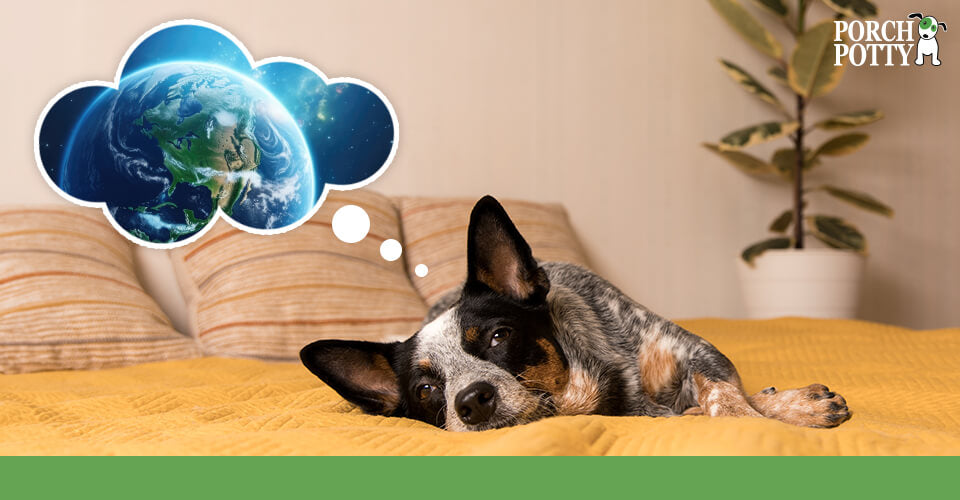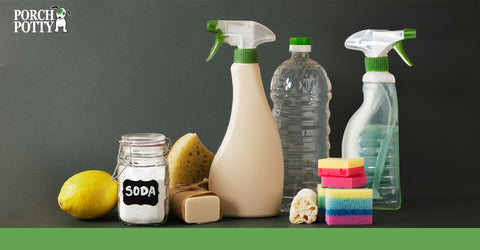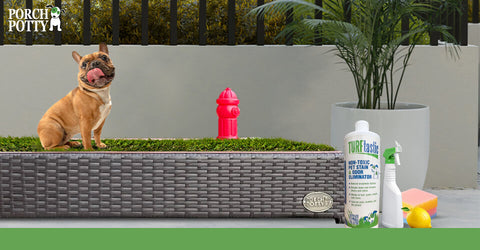
As dog owners, we need to take some time and be aware of the environmental impact of maintaining our puppies' potty areas.
Maintaining cleanliness in your dog's potty area is crucial not only for the health and hygiene of your furry friend but also for the well-being of your family and the environment. Traditional cleaning methods, while effective, often come with a heavy environmental toll, relying on chemicals that can be harmful to pets, humans, and the planet. Recognizing the importance of sustainable living, this article delves into various eco-friendly and safe ways to clean and maintain your dog's potty area. By exploring green cleaning solutions, we aim to provide pet owners with practices that are both effective in keeping areas clean and aligned with the values of environmental stewardship.
The Importance of Eco-Friendly Cleaning
In the quest to keep our homes and the planet safe, the choice of cleaning products we use, especially in areas as sensitive as our pets' potty spaces, plays a pivotal role. The impact of this choice extends beyond just the cleanliness of the area; it touches on the health of our pets, our families, and the environment at large.
Environmental Impact
Traditional cleaning products often contain a cocktail of chemicals designed to kill bacteria and leave areas sparkling clean. However, this efficacy comes at a cost. Many of these chemicals do not break down easily and can persist in the environment long after their use. When rinsed away, they can find their way into waterways, contributing to pollution and posing a threat to aquatic life. The production and disposal of these chemical-laden products further strain our planet's resources, leading to a cycle of pollution that impacts air quality, water, and wildlife. By choosing eco-friendly cleaning methods, we can significantly reduce this environmental footprint. Natural, biodegradable ingredients in green cleaning products are designed to have minimal impact, breaking down harmlessly and supporting the health of the ecosystem.
Health Benefits
The benefits of using non-toxic, eco-friendly cleaning methods extend directly into our homes, particularly for our pets and families. Traditional cleaners can leave behind residues that pets might ingest or come into contact with, leading to potential health risks such as skin irritations, respiratory issues, or more serious toxic reactions. The volatile organic compounds (VOCs) commonly found in these products can also affect air quality, potentially leading to long-term health issues for both pets and their owners.
In contrast, eco-friendly cleaning products are formulated with ingredients that are not only safe for the environment but also for the home's inhabitants. Using natural, plant-based products reduces the risk of exposure to harmful chemicals, ensuring a safer space for pets to roam and families to live. The switch to green cleaning practices supports a healthier lifestyle, contributing to improved indoor air quality and reducing the risk of allergies and chemical sensitivities.
By adopting eco-friendly cleaning methods, we embrace a holistic approach to health and environmental stewardship. This conscientious choice not only safeguards our pets and loved ones but also contributes to a larger effort to protect and preserve our planet for future generations.

Vinegar, baking soda, and lemon juice are just a few examples of natural cleaning agents.
Natural Cleaning Agents
In the journey toward sustainable and pet-friendly cleaning, several household items stand out for their natural cleaning capabilities. These agents, often found in our kitchens, offer a powerful alternative to chemical-based products, ensuring the safety of our pets and the environment. Here’s how to incorporate them into your cleaning routine:
Vinegar and Water Solution
Vinegar, particularly white vinegar, is celebrated for its disinfecting properties and ability to neutralize odors. Create an effective cleaning solution by mixing equal parts of vinegar and water in a spray bottle. This mixture can be used to clean and disinfect your dog's potty area, removing stains and odors without the use of harsh chemicals. While the scent of vinegar is strong initially, it dissipates as it dries, leaving behind a clean, odor-free area. However, always test a small area first to ensure compatibility with the surface being cleaned.
Baking Soda
Baking soda is a versatile and natural deodorizer that's effective in absorbing odors. Sprinkle baking soda generously over the potty area and let it sit for a few hours or overnight to absorb smells. Then, simply vacuum or sweep it up. For tougher stains, make a paste with water and baking soda, apply it to the stain, let it sit, and then scrub gently with a brush before rinsing. Baking soda is non-toxic and safe for use around pets, making it an ideal choice for regular maintenance cleaning.
Lemon Juice
Lemon juice acts as a natural disinfectant due to its acidic properties and leaves a refreshing scent. It can be used to clean non-porous surfaces, effectively cutting through grease and brightening surfaces. Mix equal parts of lemon juice and water for a simple cleaning solution, or use straight lemon juice for tougher areas. The natural fragrance of lemons will leave your dog's potty area smelling fresh and clean. As with any cleaning agent, it’s important to rinse the area with water after cleaning to ensure no lemon juice residue remains that could potentially irritate your pet’s paws.
Eco-Friendly Soap
For general cleaning, eco-friendly soaps are an excellent choice. These soaps are made from natural, biodegradable ingredients and are free from harsh chemicals, making them safe for pets, humans, and the environment. Look for pet-safe, eco-friendly soaps at health food stores or online, and use them for washing down surfaces. These soaps effectively remove dirt and grime without leaving harmful residues behind.
By incorporating these natural cleaning agents into your routine, you can maintain a clean and safe environment for your dog's potty area. Not only are these methods effective in keeping spaces clean and fresh, but they also align with eco-friendly practices, ensuring a healthier planet for everyone.
Sustainable Practices for Waste Disposal
Adopting sustainable practices for waste disposal is crucial in minimizing the environmental impact of pet ownership. As responsible pet owners, choosing eco-friendly methods for disposing of our dogs' waste not only contributes to a cleaner environment but also supports the health of our communities and ecosystems. Here are two effective sustainable practices to consider:
Biodegradable Poop Bags
The use of biodegradable poop bags is a simple yet impactful way to reduce plastic waste. Traditional plastic bags can take hundreds of years to decompose, contributing significantly to landfill mass and environmental pollution. In contrast, biodegradable bags are designed to break down quickly in the environment, often within months, leaving minimal ecological footprint. When selecting biodegradable bags, look for those certified as compostable to ensure they meet stringent environmental standards. By opting for these eco-friendly alternatives, pet owners can significantly reduce their pets' carbon pawprints.
Composting Pet Waste
Composting pet waste is another sustainable practice that, when done correctly, can turn waste into valuable compost for non-edible plants. It's important to note that not all pet waste is suitable for composting; for example, waste from pets on certain medications may be harmful. To compost dog waste safely, set up a separate composting bin specifically for this purpose. This bin should be placed away from edible gardens and water sources to prevent any risk of contamination. Use a balance of green (nitrogen-rich) and brown (carbon-rich) materials in your compost to encourage decomposition and reduce odors. It's crucial to ensure that the compost reaches a high enough temperature to kill any pathogens. Finished compost from pet waste should only be used on ornamental plants, not on plants intended for human consumption, due to the risk of transmitting parasites or bacteria.
By embracing these sustainable waste disposal practices, pet owners can play a part in reducing pollution and promoting a healthier planet. Whether through the use of biodegradable poop bags or the careful composting of pet waste, each small step contributes to a larger movement towards environmental responsibility and sustainability.

Porch Potty's Turftastic Odor Eliminator is an eco-friendly enzymatic cleaner designed for dogs.
Maintaining a Clean Potty Area
A clean potty area is essential for the health and well-being of your pet and family. Regular maintenance and proper care can prevent the buildup of harmful bacteria and odors, ensuring a hygienic space for your dog to use. Here are some key practices to keep your dog's potty area clean and eco-friendly:
Regular Maintenance
The foundation of a clean potty area lies in a consistent cleaning schedule. Regularly removing waste, washing down the area, and applying natural cleaning agents prevent the accumulation of bacteria and odors. Daily waste removal is essential, and a more thorough cleaning should be done weekly. This routine not only keeps the area pleasant for you and your pet but also contributes to the overall hygiene of your living space. Implementing a regular cleaning schedule is the most effective way to maintain a clean and odor-free potty area.
Proper Drainage
Ensuring proper drainage is critical in maintaining a clean and healthy potty area. Poor drainage can lead to standing water, creating a breeding ground for bacteria and unpleasant smells. If your potty area is outdoors, consider installing a slight slope to facilitate water runoff. For indoor or patio areas, use materials that promote drainage, such as permeable pavers or specially designed pet turf. These solutions allow liquids to drain away quickly, keeping the area dry and reducing the risk of bacteria growth.
Safe Water Use
Conserving water is a vital part of maintaining a clean potty area in an eco-friendly manner. One strategy to minimize water usage is to collect and use rainwater for cleaning purposes. Setting up a rain barrel is a simple and effective way to harness natural rainfall, which can then be used for washing down the potty area. Additionally, using a spray bottle filled with your vinegar water solution or eco-friendly soap for spot cleaning can significantly reduce water use compared to hosing down the area. These practices not only contribute to a clean potty area but also align with sustainable water usage, reducing the environmental impact of pet care.
By incorporating these practices into your routine, you can maintain a clean, hygienic, and eco-friendly potty area for your dog. Regular maintenance, proper drainage, and safe water use are key to creating a pleasant and sustainable space that supports the health of your pet and the planet.
Advanced Eco-Friendly Cleaning Solutions
For those looking to elevate their green cleaning game, advanced eco-friendly cleaning solutions offer powerful and safe alternatives to conventional products. These options not only maintain cleanliness and hygiene but also ensure the safety of our pets and the planet. Let’s explore some of these advanced solutions:
Enzymatic Cleaners
Enzymatic cleaners are a revolutionary approach to tackling pet stains and odors. These cleaners use natural enzymes and beneficial bacteria to break down organic matter such as urine, feces, and vomit, effectively eliminating odors at their source rather than merely masking them. Unlike traditional chemical cleaners, enzymatic cleaners do not harm the environment or pose risks to pets and humans. They are particularly effective in cleaning dog potty areas, as they can thoroughly remove stains and odors without the use of harsh chemicals.
DIY Recipes
For those who prefer a hands-on approach, making your own eco-friendly cleaning solutions is both cost-effective and environmentally friendly. Here are a couple of recipes tailored for dog potty areas:
All-Purpose Cleaner: Mix 1 part white vinegar with 1 part water, add a few drops of lemon essential oil for its natural disinfectant properties and a refreshing scent. This solution can be used for daily wiping down of the area.
Odor Eliminator: Combine 2 tablespoons of baking soda with 2 cups of water and 10 drops of lavender essential oil. The baking soda neutralizes odors, while the lavender provides a calming scent. Spray on the potty area and let dry.
Purchasing Eco-Friendly Products
When buying eco-friendly cleaning products, it’s important to look for certain certifications and ingredient transparency to ensure the product meets environmental and health standards. Look for products certified by reputable organizations such as the Environmental Protection Agency (EPA) Safer Choice, Green Seal, or EcoLogo. These certifications indicate that the product has met stringent environmental and health criteria. Additionally, check the label for a full list of ingredients — the more transparent, the better. Avoid products with phosphates, phthalates, or synthetic fragrances, as these can be harmful to both the environment and your pet.
Adopting advanced eco-friendly cleaning solutions for your dog’s potty area is a step forward in sustainable pet care. By choosing enzymatic cleaners, making your own cleaning solutions, or selecting certified eco-friendly products, you can ensure a clean, safe, and environmentally responsible home.
For more information on creating a potty area for you dog, check out these articles:
Potty Training for Pooches: How to Create a Comfortable and Effective Potty Spot for Your Dog
5 Common Mistakes in Maintaining Dog Potty Areas and How to Avoid Them
Choosing the Best Potty Solution: Training Pads vs Synthetic Grass



